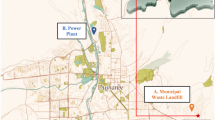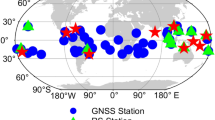Abstract
Air quality all over India has been deteriorated significantly over the last few decades, posing a significant risk to health-related issues like asthma and cardiorespiratory illness. Ground-based monitoring of particulate matter (PM2.5 and PM10) in India is limited to few particular sites only; hence, health-related studies are restricted to regional scale only. Thus, the major aim of the present study is to estimate the local PM2.5 and PM10 mass concentration from the aerosol optical depth (AOD) level. AOD levels are determined from the moderate resolution imaging spectroradiometer (MODIS) onboard Earth Observing System Aqua satellites. Moreover, the annual, seasonal, and diurnal trend of AOD over India was also studied. Single and multiple linear regression models for estimating the concentrations of PM2.5 and PM10 were also conducted. Multiple regression analyses were performed considering MODIS-based AOD with meteorological parameters like temperature, relative humidity, wind speed, solar radiation, and precipitation. The results indicated that both the PM2.5 and PM10 had a weak correlation with MODIS-based AOD for simple linear regression model, whereas the regression coefficients improved significantly for multiple linear regression analyses. Thus, the proposed multiple linear regression models can be used in the estimation of PM2.5 and PM10 concentration in different parts of the country using MODIS image without ground monitoring. Therefore, the predicted results can help to perform the air pollution-related health impact studies all over the country.






Similar content being viewed by others
References
Analitis, A., Katsouyanni, K., Dimakopoulou, K., Samoli, E., Nikoloulopoulos, A. K., Petasakis, Y., et al. (2006). Short-term effects of ambient particles on cardiovascular and respiratory mortality. Epidemiology,17, 230–233.
Bilal, M., Nichol, J. E., & Spak, S. N. (2017). A new approach for estimation of fine particulate concentrations using satellite aerosol optical depth and binning of meteorological variables. Aerosol and Air Quality Research,17, 356–367.
Central Pollution Control Board, New Delhi, Air Quality Data Mart. http://www.cpcb.gov.in/CAAQM/mapPage/frmindiamap.aspx. Accessed August, 2014.
Chitranshi, S., Sharma, S. P., & Dey, S. (2015). Satellite-based estimates of outdoor particulate pollution (PM10) for Agra City in Northern India. Air Quality, Atmosphere and Health,8, 55–65. https://doi.org/10.1007/s11869-014-0271-x.
Dey, S., & Di Girolamo, L. (2010). A climatology of aerosol optical and microphysical properties from nine years (2000–2008) of Multiangle Imaging SpectroRadiometer (MISR) data over the Indian Subcontinent. Journal of Geophysical Research,115, D15204. https://doi.org/10.1029/2009JD013395.
Diner, D. J., Beckert, J. C., Reilly, T. H., Bruegge, C. J., Conel, J. E., Kahn, R. A., et al. (1998). Multi-angle Imaging SpectroRadiometer (MISR) instrument description and experiment overview. IEEE Transaction of Geoscience Remote Sensing,36, 1072–1087.
Gautam, S., Patra, A. K., & Kumar, P. (2018). Status and chemical characteristics of ambient PM2.5 pollutions in China: A review. Environment, Development and Sustainability. https://doi.org/10.1007/s10668-018-0123-1.
Gorai, A. K., Tuluri, F., & Tchounwou, P. B. (2014). A GIS based approach for assessing the association between air pollution and asthma in New York State, USA. International Journal Environmental Research and Public Health,11, 4845–4869. https://doi.org/10.3390/ijerph110504845.
Holben, B. N., Eck, T. F., Slutsker, I., Tanre, D., Buis, J. P., Setzer, A., et al. (1998). AERONET: A federated instrument network and data archive for aerosol characterization. Remote Sensing of Environment,66(1), 1–16.
Huang, W., Cao, J., Tao, Y., Dai, L., Lu, S. E., Hou, B., et al. (2012). Seasonal variation of chemical species associated with shortterm mortality effects of PM2.5 in Xi’an, a Central City in China. American Journal of Epidemiology,175, 556–566.
Indian Meteorological Department, Ministry of Earth Sciences, Government of India, Annual Report. (2010). http://metnet.imd.gov.in/imdnews/ar2010.pdf. Accessed August, 2014.
Jonathan, M. S., Francesca, D., Frank, C. C., Ivan, C., & Scott, L. Z. (2000). Fine particulate air pollution and mortality in 20 U.S. cities, 1987–1994. The New England Journal of Medicine,343, 1742–1749.
Jonathan, O. A., Josef, G. T., & Andrew, S. (2012). Clearing the air: A review of the effects of particulate matter air pollution on human health. Journal of Medical Toxicology,8(2), 166–175.
Kahn, R. A., Gaitley, B. J., Garay, M. J., Diner, D. J., Eck, T. F., Smirnov, A., et al. (2010). Multiangle Imaging SpectroRadiometer global aerosol product assessment by comparison with Aerosol Robotic Network. Journal of Geophysical Research,115, D23. https://doi.org/10.1029/2010JD014601.
Kahn, R. A., Garay, M. J., Nelson, D. L., Yau, K. K., Bull, M. A., Gaitley, B. J., et al. (2007). Satellite-derived aerosol optical depth over dark water from MISR and MODIS: Comparisons with AERONET and implications for climatological studies. Journal of Geophysical Research,112, D18205.
Kaufman, Y. J., Tanre, D., & Boucher, O. (2002). A satellite view of aerosols in the climate system. Nature,419, 215–223.
Kaufman, Y. J., Tanre, D., Gordon, H. R., Nakajima, T., Lenoble, J., Frouin, R., et al. (1997). Passive remote sensing of tropospheric aerosol and atmospheric correction for the aerosol effect. Journal of Geophysical Research,102(D14), 16815–16830.
Keitzl, T., Kaleschke, L., & Mellado, J.-P. (2015). Turbulent enhancement of the melt-rate at an ice-ocean interface. Hamburg: Universität Hamburg Berichte zur Erdsystemforschung. https://doi.org/10.17617/2.2239535.
King, M. D., Menzel, W. P., Kaufman, Y. J., Tanré, D., Gao, B., Platnick, S., et al. (2003). Cloud and aerosol properties, precipitable water, and profiles of temperature and water vapor from MODIS. IEEE Transaction on Geoscience Remote Sensing,41(2), 442–458.
Kleidman, R. G., Smirnov, A., Levy, R. C., Mattoo, S., & Tanré, D. (2012). Evaluation and wind speed dependence of MODIS aerosol retrievals over open ocean. IEEE Transaction on Geoscience Remote Sensing,50, 429–435.
Lee, H. J., Coull, B. A., Bell, M. L., & Koutrakis, P. (2012). Use of satellite-based aerosol optical depth and spatial clustering to predict ambient PM2.5 concentrations. Environmental Research,118, 8–15. https://doi.org/10.1016/j.envres.2012.06.011.
Levy, R. C., Remer, L. A., Kleidman, R. G., Mattoo, S., Ichoku, C., Kahn, R., et al. (2010). Global evaluation of the collection 5 MODIS dark-target aerosol products over land. Atmospheric Chemistry and Physics,10, 10399–10420.
Mahowald, N. (2011). Aerosol indirect effects on biogeochemical cycles and climate. Science,334, 794–796.
Massey, D. D., Aditi, K., & Ajay, T. (2013). Particulate matter concentrations and their related metal toxicity in rural residential environment of semi-arid region of India. Atmospheric Environment, 67, 278–286.
Mellado, J.-P., van Heerwaarden, C., & Garcia, J. (2016). Near-surface effects of free atmosphere stratification in free convection. Boundary Layer Meteorology,159, 69–95. https://doi.org/10.1007/s10546-015-0105-x.
Mishchenko, M. I., Liu, L., Geogdzhayev, I. V., Li, J., Carlson, B. E., Lacis, A. A., et al. (2012). Aerosol retrievals from channel-1 and -2 AVHRR radiances: Long-term trends updated and revisited. Journal of Quantitative Spectroscopy and Radiative Transfer,113(15), 1974–1980.
NASA Earth Science Data and Information System (ESDIS). MODIS data. http://ladsweb.nascom.nasa.gov/data/search.html. Accessed August, 2014.
Ostro, B., Broadwin, R., Green, S., Feng, W.-Y., & Lipsett, M. (2006). Fine particulate air pollution and mortality in nine California counties: Results from CALFINE. Environmental Health Perspectives,114, 29–33.
Pauli, P., Ari, A., Tuukka, P., Maija, K. K., Mikko, Ä., Heikki, J., et al. (2013). Warming-induced increase in aerosol number concentration likely to moderate climate change. Nature Geoscience,6, 438–442.
Pawan, G., Maudood, N. K., Arlindo, D. S., & Falguni, P. (2013). MODIS aerosol optical depth observations over urban areas in Pakistan: Quantity and quality of the data for air quality monitoring. Atmospheric Pollution Research,4, 43–52.
Payra, S., Soni, M., Kumar, A., Prakash, D., & Verma, S. (2015). Intercomparison of aerosol optical thickness derived from MODIS and in-situ ground datasets over Jaipur: A semi-arid zone in India. Environmental Science and Technology,49(15), 9237–9246. https://doi.org/10.1021/acs.est.5b02225.
Pope, C. A., Ezzati, M., & Dockery, D. W. (2009). Fine particulate air pollution and life expectancy in the United States. The New England Journal of Medicine,360, 376–386.
Ramanathan, V., Crutzen, P. J., Kiehl, J. T., & Rosenfeld, D. (2001). Aerosols, climate, and the hydrological cycle. Science,294, 2119–2124.
Robert, D. B., Sanjay, R., Pope, C. A., Jeffrey, R. B., Aruni, B., Ana, V. D., et al. (2010). Particulate matter air pollution and cardiovascular disease: An update to the scientific statement from the American Heart Association. Circulation,121, 2331–2378.
Sarath, K. G., & Ramani, V. K. (2014). Source emissions and health impacts of urban air pollution in Hyderabad, India. Air Quality Atmosphere and Health,7(2), 195–207.
Sayer, A. M., Thomas, G. E., Palmer, P. I., & Grainger, R. G. (2010). Some implications of sampling choices on comparisons between satellite and model aerosol optical depth field. Atmospheric Chemistry and Physics,10, 10705–10716.
Seinfeld, J. H., & Pandis, S. N. (2006). Atmospheric chemistry and physics: From air pollution to climate change (2nd ed.). New York: Wiley.
Simpson, R., Williams, G., Petroeschevsky, A., Best, T., Morgan, G., Denison, L., et al. (2005). The short-term effects of air pollution on daily mortality in four Australian cities. Australian and New Zealand Journal of Public Health,29, 205–212.
The National Centers for Environmental Prediction (NCEP). http://globalweather.tamu.edu/home. Accessed August, 2014.
van Donkelaar, A., Martin, R. V., & Park, R. J. (2006). Estimating ground-level PM2.5 using aerosol optical depth determined from satellite remote sensing. Journal of Geophysical Research,111, D21201. https://doi.org/10.1029/2005JD006996.
Wan Mahiyuddin, W. R., Sahani, M., Aripin, R., Latif, M. T., Thach, T. Q., & Wong, C. M. (2013). Short-term effects of daily air pollution on mortality. Atmospheric Environment,65, 69–79.
Acknowledgements
Authors are also thankful to Central Pollution Control Board, New Delhi, for making air pollution data available on the website for public use, and to NASA, USA, for making MODIS satellite products available on the website.
Author information
Authors and Affiliations
Corresponding author
Ethics declarations
Conflict of interest
The authors declare no conflict of interest.
Rights and permissions
About this article
Cite this article
Shaw, N., Gorai, A.K. Study of aerosol optical depth using satellite data (MODIS Aqua) over Indian Territory and its relation to particulate matter concentration. Environ Dev Sustain 22, 265–279 (2020). https://doi.org/10.1007/s10668-018-0198-8
Received:
Accepted:
Published:
Issue Date:
DOI: https://doi.org/10.1007/s10668-018-0198-8




